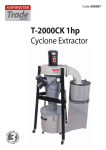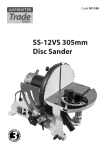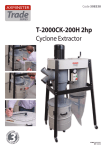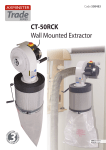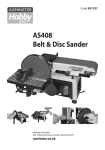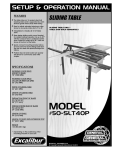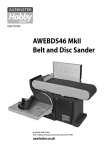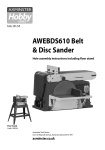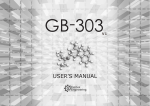Download Axminster BDS-612 Instruction manual
Transcript
Code 505091 BDS-612 Belt & Disc Sander Linisher angled at 90˚ (degrees) Index of contents Index of Contents 02 Declaration of Conformity 02 What’s Included 03-04-05 General Instructions for 230V Machines 06 Specific to Sanding Machines 07 Specification08 Assembly08-09-10-11-12 Identification and Description 13-14 Setup/Adjustments15-16-17 Operation Instructions 17 Sanding Configurations 17 Changing the Abrasive Disc and Belt 18-19 Maintenance20 Troubleshooting20 Parts Breakdown/List 21-22-23-24-25 Wiring Diagram 26 Notes27 Declaration of Conformity Copied from CE Certificate Manufactured by META INTERNATIONAL CO., LTD. is in compliance with the standards determined in the following Council Directive. The undersigned, George N. Sifonios authorised by Applicable Directive: META INTERNATIONAL CO., LTD. NO. 38-46, YA TAN Rd., TA YA HSIANG. TAICHUNG HSIEN, TAIWAN, R.O.C. 2006/42/EC (amending 98/37/EC) Model Number BDS-612 (Sander) Applicable Standards: EN ISO 12100-1:2003, EN ISO 12100-2:2003, EN 60204-1:2006 Warning Fully read manual and safety instructions before use Ear protection should be worn The symbols below advise that you follow the correct safety procedures when using this machine. Eye protection should be worn 2 Dust mask should be worn HAZARD Motor gets hot What’s Included Qty 1 No 1 No 1 No 1 No 1 No 1 No 1 No 1 No 1 No Model Number BDS-612 Item Part BDS-612 Belt & Disc Sander (with motor aluminium table & base) Mitre Fence Linisher Assembly Linisher Guard Cover Idler Roller Guard Cover Linisher Cust Iron Table Linisher Small Table Ball Bearing Assembly Linisher Sanding Belt A B C D E F G H I Bag Containing: 1 No M8x30mm Bolt & Washer 4 No M8x20mm Hex Bolts 6 No M6x10mm Hex Screws 4 No M6x10mm Socket Button Head Screws 1 No M6 Small Star Knob 2 No M6 Large Star Knobs 1 No 6,5,4mm Hex Keys 1 No 22mm and 10-13mm Spanner 1 No A J K L M N O P Q Instruction Manual C B I F D G E H 3 Continues Over... What’s Included J K N L M Q O P Leg Stand Assembly Quantity Item Part Bag Containing: 4 No 36 No 36 No Rubber Feet Coach Bolts (5/16”) Shake Proof Nuts (5/16”) R S T 4 No 2 No 2 No Leg Brackets Middle Support Brackets (Long) Middle Support Brackets (Short) U V W R S 4 T What’s Included W U V NOTE: Please read the Instruction Manual prior to using your new machine; as well as the operating procedures for your new machine, there are numerous hints and tips to help you to use the machine safely and to maintain its efficiency and prolong its life. Having unpacked your sander and it’s various components, if you do not wish to retain the packaging please dispose of it responsibly, especially any polystyrene; most of the remaining packaging is biodegradable. Having opened the box, remove all the components stowed in the packaging. Place these carefully to one side. Remove the top packaging and lift the machine out of the box and place upon a clear flat surface, taking care not to trap or pinch the power cable under the chassis. Keep this Instruction Manual readily accessible for any others who may also be required to use the machine. Remove any other items from the box. 5 General Instructions for 230V Machines However when you mount your machine, make sure it is fastened down and stable before use. Good Working Practices/Safety The following suggestions will enable you to observe good working practices, keep yourself and fellow workers safe and maintain your tools and equipment in good working order. Paper belts and discs do not respond well to wet or damp conditions. In the worst case the adhesives holding the belt and the abrasive fail completely, the belts fall apart and the abrasive becomes a soggy mess against the edge of your work piece. WARNING! KEEP TOOLS AND EQUIPMENT OUT OF THE REACH OF YOUNG CHILDREN! Try to keep the machine in a dry environment. If this is not possible; or if the machine is to remain unused for some time, remove the belt, put in a sealed ‘plastic’ bag and store in a warm dry place. Mains Powered Tools (General) /Disc & Belt Sander Primary Precautions I can offer no suggestions for the disc, unless you have upgraded to some form of ‘Velcro’. fastening method, in which case, do the same as with the belt. These machines are supplied with a moulded 13 Amp. Plug and 3 core power cable. Before using the tool inspect the cable and the plug to make sure that neither are damaged. If any damage is visible have the tool inspected/repaired by a suitably qualified person. If it is necessary to replace the plug, it is preferable to use an ‘unbreakable’ type that will resist damage on site. Keep the work area as uncluttered as is practical, this includes personnel as well as material. Only use a 13 Amp plug, make sure the cable clamp is tightened securely. Fuse at 5 Amp. It is also good practice to use switched outlets. If extension leads are to be used, carry out the same safety checks on them, and ensure that they are correctly rated to safely supply the current that is required for your machine. UNDER NO CIRCUMSTANCES SHOULD CHILDREN BE ALLOWED IN WORK AREAS! WARNING! THE SANDING DISC CANNOT BE DECLUTCHED FROM THE BELT AND VICE VERSA, BOTH FUNCTIONS ARE ACTIVE WHEN THE MACHINE IS RUNNING. REMEMBER THIS, AND DO NOT LEAVE LOOSE OBJECTS OF ANY DESCRIPTION, ON THE MACHINE IF IT IS GOING TO BE USED! This machine is intended primarily for inside/workshop usage. Work Place/Environment Always mount the machine on a flat, level stable surface. There are several methods of achieving this, bolting the machine directly to a ‘good solid workbench’, bolting the machine to a sturdy base board that can be clamped to the ‘good solid workbench’; create an independent entity by bolting the machine to its own stand. 6 Specific to Sanding Machines DO NOT use the machine within the designated safety areas of flammable liquid stores or in areas where there may be volatile gases. There are very expensive, very specialised machines for working in these areas, THIS IS NOT ONE OF THEM. Once the sander is mounted, carry out any setting operations, (mitre, tilt..?), and remove all tools used in the setting operations (if any) and place safely out of the way. If you are working long lengths of material, arrange for extra support beyond the boundary of the machine, and check you have sufficient room to manoeuvre the material through all the operations you will wish to carry out. CHECK that sanding surfaces are still sufficiently abrasive to carry out the work you intend. Sanding belt cleaning sticks are an efficient method of prolonging the life of the belts and discs, and will also maintain their operating performance. It is good practice to leave the machine unplugged until work is about to commence, also make sure to unplug the machine when it is not in use. Always disconnect by pulling on the plug body and not the cable. CHECK that the belts or discs are undamaged; torn edges can pick up on the work piece and will cause the medium to tear, often very rapidly with accompanying sharp flapping edges. After fitting a new sanding disc, it is good practice to lightly sand across the left side of the disc with a reasonable sized (20mm x 50mm) piece of timber to make sure the sanding disc is correctly ‘seated’ on the disc. The sanding action will press the sanding disc firmly back against the disc itself. ALWAYS offer the work piece to the belt/disc so that the motion carries the work against the restraining surface, (i.e. the work stop or the table, (use the left hand side of the disc). It is not good practice to wear gloves whilst sanding as one tends to lose the ‘feel’ of the work piece/sander contact, but obviously this removes the safety barrier between your fingers and the sanding surface. Remain focused and exercise caution whilst sanding. DO NOT press too heavily against the sanding surface, all this will do is slow the sander down. Remember, sanders work by removing small particles of material quickly and heavy pressure works adversely to the cutting process, further, it will accelerate the rate of ‘clogging’ of the abrasive surfaces, rendering the machine less efficient. DO NOT sand very small pieces of work with bare hands; try to construct some form of holder. MAKE SURE you are comfortable before you start work, balanced, not reaching etc. If the work you are carrying out is liable to generate excessive grit or dust or chips, wear the appropriate safety clothing, goggles, masks etc., If the work operation appears to be excessively noisy, wear ear-defenders. If you wear your hair in a long style, wearing a cap, safety helmet, hair net, even a sweatband, will minimise the possibility of your hair being caught up in the rotating parts of the machine, likewise, consideration should be given to the removal of rings and wristwatches, if these are liable to be a ‘snag’ hazard. If you are attempting to sand inside curves (over the ‘tracking drum’) do not press at all,other than to keep the work piece in contact with the surface, any pressure could upset the tracking geometry. As there is no cushioning effect to the belt passing around the drum, expect an added vibration and compensate for it. Sanding of certain types of timber may make the fitting of dust extraction mandatory in order to comply with the directives of the HSE. However, even if it is not mandatory, it is strongly recommended that you consider fitting dust extraction. It will certainly reduce the level of dust and grit, and as it helps to remove the waste quicker, will certainly prolong the longevity of the abrasive. DO NOT work with cutting/abrasive tools of any description if you are tired, your attention is wandering or you are being subjected to distraction. A deep graze, a lost fingertip or worse, is not worth it! Above all, OBSERVE…. make sure you know what is happening around you, and USE YOUR COMMON SENSE. 7 Specification ModelBDS-612 Code505091 RatingTrade Power 0.93kW (230V, 1ph) Belt Speed 730m/min Belt Size 152 x 1220mm Diameter of Disc 305mm Table Size Belt 305mm x 150mm Table Size Disc 400 x 225mm Dust Extraction Outlet 65mm x 2 Overall L x W x H 780 x 420 x 740mm Weight61kg Assembly In order to reduce the footprint of the machine for packaging, several items are dismounted from the machine and needs to be re-affixed. Step 3 Position each leg (U) to each corner of the sanders base (A), lineup the holes and lightly secure with the coach bolts (S) and shake proof nuts (T), see fig 03-04. Stand Assembly Step 1 Locate the sander assembly (A), the four leg brackets (U), the bag of fixing containing the coach bolts (S) and shake proof nuts (T). Fig 03-04 Step 2 Remove the lift and shift handle to the right side of the sanding disc table to prevent it from being damaged, see fig 01 and very carefully turn the sander on it’s side, see fig 02. A Fig 01-02 U S Lift & shift handle T Step 4 Locate the long middle support brackets (V) and short brackets (W). Lineup the holes in the brackets (V) with the holes in the centre of the legs and lightly secure with the coach bolts (S) and nuts (T), see fig 05. A 8 Assembly Step 5 Lineup the short brackets (W) with the holes in the legs (U) and the slotted holes in the brackets (V), lightly secure with the coach bolt and nuts as before (see figs 06-07). Fig 08 Fig 05 R Warning: We advise you seek help when lifting the sander! V Fig 06-07 Step 7 With help, lift the sander and place upright on the floor. (See figs 09 -10) Now go round and tighten all the nuts using a 13mm spanner. Replace the lift and shift handle you removed earlier. Fig 09-10 W Step 6 Locate the four rubber feet (R), place a foot to the end of one the legs (U), lineup the slotted groove in the foot, using a high faced mallet lightly tap in place, see fig 08. Repeat for the remaining feet. 9 Continues Over... Assembly Fig 13-14 Linisher Assembly WARNING! The linisher assembly is heavy, we advise you seek help to assemble the unit! C Step1 Locate the linisher assembly (C) and the four M8x20mm Hex bolts (K). Loosen the three nuts clamping the linisher mounting plate, turn the plate until the pointer reads (zero) on the scale then retighten the nuts, see fig 11. P Fig 11 P K Step 2 Lower the machined cutout in the linisher (C) over the drive roller, lineup the pre-drilled holes in the linisher with the four threaded holes in the mounting plate and using the supplied 6mm Hex key (P) secure in place with the four M8 Hex bolts (K), see figs 12-13-14. Step 3 Locate the ball bearing assembly (H) and four M6x10mm Hex screws (L). Push the ball bearing assembly Fig 15-16 Fig 12 Machined cutout C H L K P 10 Assembly onto the end of the motor shaft, line up the holes in the linisher and secure in place with the four M6x10mm Hex screws (L) and tighten using the supplied 5mm Hex key (P) (see figs 15-16). Fig 20 Step 3 Loosen the three nuts clamping the linisher mounting plate and raise the linisher into the upright position, with the index pointer reading 90˚ on the scale. Retighten the nuts, see figs 17. Fig 17 Step 5 Locate the linisher guard cover (D), the four M6x10mm socket button head screws (M), the small M6 star knob (N) and the two M6 large star knobs (O). Position the guard cover (D) over the lower section of the linisher and lineup the pre-drilled holes, see fig 21. Screw two M6 screws Fig 21 D Step 4 Raise the belt tensioning lever, see fig 18 locate the linisher’s sanding belt (I), unroll the belt and slide the belt over the drive rollers and adjust until central, see fig 19. Lower the belt tensioning lever, see fig 20. Fig 18 (M) in the lower two holes to the right side of the linisher, see fig 22 close the hinged door, screw one of the M6 large knobs (O) through the pre-drilled hole above the bearing assembly (H) and into the linisher (C), screw the small M6 knob (N) into the lower hole, see fig 23. Fig 22 Fig 19 I M P M 11 Continues Over... Assembly Fig 23 Fig 26 O N Fig 27-28 Step 6 Locate the idler roller guard cover (E), lower the guard over the roller and line up the holes with the holes in the linisher guard cover (D) secure using the remaining M6 screws (M) and the M6 larger star knob, see figs 24-25. Fig 24-25 M Pin the bolt through the machined slot in the tables bracket and into the threaded hole in the linisher, tighten with a 13mm spanner (see fig 29). Fig 29 O Step 7 Locate the linisher’s small table (G) and the remaining M6 Hex screws (L). Offer up the two pre-drilled holes with the thread holes in the linisher mounting plate and secure with the two M6 screws (L) (see fig 26). Step 8 Locate the cast iron table (F)and the M8x30mm bolt and washer (J), slot the machined hole in the table’s bracket over the pin to the side of the linisher and push home, see figs 27-28. Place the M8 washer over the bolt (J), introduce Step 9 Locate the mitre fence (B) and slide it into the tables ‘T’ slot from the right side (See fig 30). Fig 30 12 Identification and Description 2 1 3 4 5 6 7 15 8 14 9 13 10 Linisher angled at 90˚ (degrees) 12 11 16 No Part No 1 Linisher Abrasive Belt Description I 9 Cast Iron Disc Table Description Part 2 Idler Roller Guard E 10 Stand Assembly 3 Linisher Guard D 11 Rubber Feet R Table Clamping Handle - UVW 4 Belt Tensioning Lever - 12 5 Motor - 13 NVR Switch Assembly - Linisher Small Table G 6 Abrasive Disc - 14 7 Disc Guard - 15 Linisher Cast Iron Table F B 16 Linisher Pointer & Scale - 8 Mitre Fence 13 Identification and Description Clamping knob Pointer Scale Mitre fence assembly Belt sanding table pointer and scale Linisher dust extraction output Disc extraction output Emergency stop Off On NVR Switch assembly Linisher belt tracking knob Disc sanding table pointer and scale 14 Motor “REST” button Setup/Adjustment Fig 33 Setting the table clearance The gap between the table and the disc should be set to a maximum of 1.6mm to clear the debris and to ensure sufficient support for the timber. The table should be positioned so that sanding only occurs from downward movement of the disc/belt face. Small pieces of timber should not be disc sanded. A responsible person should check the setting of the machine before use. 1.6mm Disc table adjustment Step 1 To set the table clearance, first remove the guard by undoing the two Phillips screws (a), place screws and guard safely aside (see fig 31). Place a rule up against the sanding disc and adjust the table until there is a clearance of 1.6mm. Fig 31 Fig 34 a 90˚Square Step 2 Locate the supplied spanner (Q) loosen the six bolts beneath the table brackets, (see fig 32) place a rule up against the sanding disc and adjust the table until there is a 1.6mm clearance between the table and the disc, (see fig 33). Step 3 Replace the disc guard as described above. Step 4 Place the 90˚ square against the disc and mitre fence, (see fig 34) to check the table is square then tighten the six nuts beneath the table. NOTE: MAKE SURE THE MITRE FENCE IS SET TO ZERO ON THE SCALE! Step 5 Place the square upright against the sanding disc, loosen the two clamping handles (b) on either side of the table and adjust the table’s angle, until it’s perpendicular to the sanding disc (see fig 35). Tighten the clamping handles. Fig 32 Fig 35 90˚Square b Bolts 15 Setup/Adjustment angle, until it’s perpendicular to the sanding belt, see fig 39. Retighten the bolt. Fig 36 Fig 39 Belt Table adjustment Step 1 Loosen the four Hex bolts (c)beneath the table brackets, see fig 37 place a rule up against the sanding belt and adjust the table until there is a 1.6mm clearance between the table and the belt, (see fig 33). Step 4 Check the pointer is reading “ZERO” on the scale, if not, loosen the Phillips screw and adjust the pointer until correct, see fig 40. Fig 40 Fig 37 c Step 2 Place the 90˚ square against the belt and mitre fence, (see fig 38) to check the table is square then tighten the four Hex bolts beneath the table. Fig 38 Tracking the Belt NOTE1 All directions are given from the view point of the operator standing behind the drive drum end looking down the length of the machine. The tracking control works as follows:- turning the tracking adjuster clockwise will track the belt to the right, anti-clockwise will track the belt to the left, see fig 41. DO NOT make large adjustments, and remember the belt may take some time to react to your alteration. Little by little is a good maxim to observe when carrying out tracking operations. Step 3 Place the square upright against the sanding belt, loosen the bolt to the side of table and adjust the table NOTE 2 Using your hand, roll the belt towards the drive drum end, check that the belt stays in the middle of the table, if not, adjust the track control slightly, and move the belt again, continue until the belt runs down the centre of the linishing table. 16 Sanding Configurations Fig 41 Operating Instructions Bevel Sanding WARNING! KEEP TOOLS AND EQUIPMENT OUT OF THE REACH OF YOUNG CHILDREN! CLEAR ALL TOOLS AWAY FROM SANDING AREA! WARNING! WEAR EYE AND EAR PROTECTION! Belt Sanding WARNING! WEAR A DUST MASK! WARNING! The sander produces very fine dust particals, it is recommended to connect the sander to a workshop Vacuum Extractor, see our catalogue or website for details! CONNECT THE SANDER TO THE VACCUM EXTRACTOR WITH SUITABLE SIZE HOSES! Curve Sanding (idler roller guard removed) CONNECT THE SANDER TO THE MAINS AND SWITCH ON. Don’t press too heavily against the sanding surface, all this will do is slow the sander down. Remember, sanders work by removing small particles of material quickly and heavy pressure works adversely to the cutting process, further, it will accelerate the rate of ‘clogging’ of the abrasive surfaces, rendering the machine less efficient. 17 Surface Sanding Changing the Abrasive Disc and Belt Fig 45 Sanding Disc DISCONNECT THE SANDER FROM THE MAINS SUPPLY BEFORE CONTINUING! Fig 42 Step 4 Locate the supplied spanner (C) and using the 10mm end remove the two nuts on either side of the extraction housing (see fig 45). Fig 46 Step 1 Remove the two table clamping handles (see fig 42). Fig 43 Step 5 Lower the extraction housing (see fig 46). Fig 47 Step 2 Remove both Phillips screws on either side of the table and place safely aside (see fig 43). Fig 44 Step 6 Lift the edge of the disc and, gripping firmly, peel the disc away from the plate; turning the plate as required to free the entire disc (see fig 47). Clean the surface of the disc with a de-greasing cleaner. Allow to dry off and wipe over with a Step 3 Lift the table assembly away and place to one side (see fig 44). 18 Changing the Abrasive Disc and Belt clean dry cloth. Locate the sanding disc, peel the cover from the adhesive surface and apply CAREFULLY to the disc (see fig 48). Use a piece of cloth in your hand or wear a glove, to firmly press the abrasive to the disc, the application will be reinforced by a gentle sanding action across the face when you first use the new sanding disc. Step 2 Remove the three locking knobs (O) and (N) from the side of the linisher guards and place safely aside, open the guard’s access doors (see fig 50). Fig 50 Step 7 Re-assemble the sander as described opposite but in reverse. I Fig 48 O Turn the disc while applying pressure RECONNECT THE SANDER TO THE MAINS SUPPLY AND CONTINUE WITH OPERATION. Step 3 Remove the linisher’s sanding belt (I). Inspect the new belt, ensure that there are no tears or rips (especially along the edges), check the direction arrows on the inner surface of the belt and fit accordingly. (The direction of the arrows should point to the drive drum end of the machine). Note: If you are using an old belt, and the arrow marking has worn off, check the direction of travel (see diagram below.) Sanding Belt DISCONNECT THE SANDER FROM THE MAINS SUPPLY BEFORE CONTINUING! Step 1 Release the tension on the belt by lifting the tensioning lever, see fig 49. Fig 49 N Direction of travel Belt underlay Belt overlay Glue joint NOTE: Before sliding on the new belt check there is no dust or resin build up on the drums or at the edges of the linisher, clean in and around the extraction ports for dust or resin build up. Step 4 Slide on the new belt and refer to Page 16 for tracking the belt, once done close the linisher’s access doors and replace the locking knobs (O) and (N). Press down the tension lever to re-tension the belt. RE-CONNECT THE SANDER TO THE MAINS SUPPLY AND CONTINUE WITH OPERATION. 19 Maintenance DISCONNECT THE SANDER FROM THE MAINS SUPPLY BEFORE CONTINUING! There is very little mechanical maintenance that can be carried out on the machine. Most prudent maintenance is preventative and concerned with keeping the machine clean. 1. At reasonable intervals, inspect and remove all dust/resin build ups, and blow the motor clean. 2. Remove the table assembly and lower the extraction housing, clean any dust or resin build up. Re-assemble the sander. 3. Inspect the sanding disc for signs of wear and tear and replace if necessarily. 4. Inspect the linisher’s sanding belt for signs of wear and tear and replace if necessary. 5. From time to time using a damp cloth wipe over the sander’s surface. Troubleshooting Trouble Probable Cause Remedy Motor does not run when power switch is pressed “ON” 1. Switch is burnt out 2. Connection wire is loose or damaged 1. Replace the switch 2. Tighten wire or replace Motor does not run at full speed 1. Power voltage is too low 2. Motor is damaged. 1. Test voltage 2. Check and repair motor Motor does not reach full power 1. Incorrect power wiring 2. Overloaded 1. Replace with the correct size of power wiring 2. Reduce load Motor overheating 1. Motor voltage is different 2. Motor is damaged 1. Check the voltage label 2. Check and repair the motor Motor stalls while in use 1. To much pressure being placed on sanding surface. 2. Motor getting too hot. 1. Don’t press to heavily on abrasive surface. 2. Leave the sander to cool down for 30 minutes and press the “RESET” button 20 Parts Breakdown/List BDS-612 Exploded diagram 21 Parts Breakdown/List BDS-612 List NO Axminster No Description 1 505091-1 Base 2 505091-2 Motor base 3 505091-3 Motor 4 505091-4 Disc cover 5 505091-5 Aluminium disc 12” 1 Sanding paper 12” 1 6 Specification Qty 1 1 1-1/2HP 1 1 7 505091-7 Aluminium table 1 8 505091-8 Left tilting turning 1 9 505091-9 Right tilting turning 1 10 505091-10 Dust hood cover 11 505091-11 Left safety guard 1 12 505091-12 Right safety guard 1 13 505091-13 Platen 1 14 505091-14 Cast iron table of platen 1 15 505091-15 Tilting turning of platen 1 16 505091-16 Platen packing 1 17 505091-17 Drive roller 1 18 505091-18 Idler roller 1 19 505091-19 Idler roller shaft 1 20 200183 Ball bearing 6201ZZ 2 21 505091-21 C-type ring S-12 1 22 505091-22 Idler roller bracket 1 23 505091-23 Push spindle 1 24 505091-24 Fixing spindle 1 25 505091-25 Push fixing bracket 1 26 505091-26 Ball bearing cover 1 27 200187 Ball bearing 1 28 505091-28 Platen table stop 1 29 505091-29 Platen cover 1 30 505091-30 Idler roller cover 1 31 505091-31 Handle 1 32 505091-32 Fixing plate 1 33 505091-33 Graphite paper 1 34 2-1/2” Sanding paper 6” x 48” 22 1 1 Parts Breakdown/List 35 505091-35 Tilting turns spindle 1 36 505091-36 Switch plate 1 37 505091-37 Knob 2 38 505091-38 Pointer 1 39 Round head screw M4x8 7 40 Round head screw M6x8 2 41 Washer 42 Hex. head screw 43 Hex. head screw 44 Washer 45 46 Nut 505091-46 Tilting label sticker M6 4 M6x10 2 M6x12 6 1/4” x 13 6 M6 6 -15 ~45 degree 1 M8x12 6 M8 6 47 Hex. head screw 48 Spring washer 49 Hex. head screw M8 x 25 4 50 Washer M8x18 5 51 Nut M8 7 52 Hex. head screw M8x16 2 53 Hex. bolt M8x15 1 54 Hex. bolt M8x18 3 55 Hex. bolt M8x20 4 56 Hex. bolt M8x25 1 57 Hex. bolt M5x25 1 58 Hex. bolt M6x25 2 59 Hex. bolt M6x15 3 60 Hex. head screw M8x30 1 Pan head screw M6x20 4 61 62 505091-62 63 Pointer 1 Set screw 64 505091-64 Push back spring 65 505091-65 Push back spring 66 505091-66 Adjusting screw 6x10 4 1 1 M8x50 1 67 Nut M6 2 68 Nut M10 1 Hex. bolt M6x10 4 Polygon knob M6x10 2 69 70 505091-70 23 Continues Over... Parts Breakdown/List 71 505091-71 Pentagon knob M6x10 1 72 505091-72 Knob M6x22 1 73 505091-73 Mitre gauge 74 505091-74 Pin 3/16” x 20 1 Round head screw 3/16” x 6 1 75 1 76 505091-76 Pointer 77 505091-77 Mitre bar 78 505091-78 90 degree sticker 0-90 degree 1 79 505091-79 60 degree sticker -15-45 degree 1 80 1 1 Power cord 1 81 950697 Switch 82 505091-82 Sprain release 1 83 505091-83 Connector 1 84 505091-84 Ball bear packing 1 85 505091-85 Key 86 505091-86 Pointer 6W-4S 6 x 6 x50 3 1 1 87 Set Screw M5x10 2 88 Open end wrench 22mm 1 89 Open end wrench 10-13mm 1 90 Hexagon wrench M6 1 91 Hexagon wrench M5 1 92 Hexagon wrench M4 1 93 Round head screw M5x8 4 94 Hex. bolt M6x10 4 95 505091-95 96 Washer 97 NOT SHOWN Temperature control switch Hex. bolt 505091-CAP 1 6.5x16x2 CAPACITOR FOR MOTOR 24 1 M6x30 1 30MFD X 400V WIRE ENDED 90X50MM 1 Parts Breakdown/List BDS-612 Stand NO Axminster No Description Specification Qty 1 505091-STAND-1 Leg 618x702mm 4 2 505091-STAND-2 Middle support (long) 671 x44.5x 1.6 2 3 505091-STAND-3 Middle support (short) 466 x44.5x 1.6 2 505474 STAND NUT AND BOLT PACK COMPLETE. 4 Screw 5/16” x 1/2” 36 5 Nut 5/16” 36 6 Foot pad 55x55x12 4 25 Wiring Diagram 26 Notes 27 Please dispose of packaging for the product in a responsible manner. It is suitable for recycling. Help to protect the environment, take the packaging to the local recycling centre and place into the appropriate recycling bin. Only for EU countries Do not dispose of electric tools together with household waste material. In observance of European Directive 2002/96/EC on waste electrical and electronic equipment and its implementation in accordance with national law, electric tools that have reached the end of their life must be collected separately and returned to an environmentally compatible recycling facility. Axminster Tool Centre, Unit 10 Weycroft Avenue, Axminster, Devon EX13 5PH axminster.co.uk




























